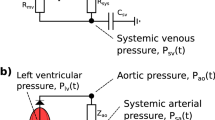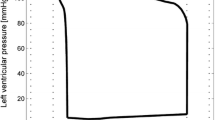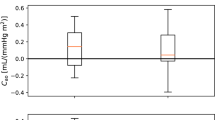Abstract
Cardiovascular health is currently assessed through a variety of hemodynamic parameters, many of which can only be determined by invasive measurement often requiring hospitalization. A noninvasive method of evaluating several of these parameters such as systemic vascular resistance (SVR), maximum left ventricular elasticity E_LV end diastolic volume V ED and cardiac output, is presented. The method has three elements: (1) a distributed model of the human cardiovascular system (Ozawa [et_al.], Ann. Biomed. Eng. 29:284–297, 2001) to generate a solution library that spans the anticipated range of parameter values, (2) a method for establishing the multidimensional relationship between features computed from the arterial blood pressure and/or flow traces (e.g., mean arterial pressure, pulse amplitude, mean flow velocity) and the critical hemodynamic parameters, and (3) a parameter estimation method that yields the best fit between measured and computed data. Sensitivity analyses were used to determine the critical parameters, and the influence of fixed model parameters. Using computer-generated brachial pressure and velocity profiles (which can be measured noninvasively), the error associated with this method was found to be less than 3% for SVR, and less than 10% for E LV and V ED Simulations were also performed to test the ability of the approach to predict changes in SVR and E LV from an initial base line state. © 2002 Biomedical Engineering Society.
PAC2002: 8719Hh, 8719Uv
Similar content being viewed by others
REFERENCES
Adams, H. R., C. R. Baxter, and S. D. Izenberg. Decreased contractility and compliance of the left ventricle as complications of thermal trauma. Am. Heart J. 108:1477–1487, 1984.
Belani, K., M. Ozaki, J. Hynson, T. Hartmann, H. Reyford, J. M. Martino, M. Poliac, and R. Miller. A new noninvasive method to measure blood pressure: Results of a multicenter trial. Anesthesiology 91:686–692, 1999.
Barton, R., and J. Ivey. Nelder-mead simplex modifications for simulation optimization. Management Sci. 42:954–973, 1996.
Beards, S. C., and J. Lipman. Decreased cardiac index as an indicator of tension pneumothorax in the ventilated patient. Anaesthesia 49:137–141, 1994.
Cameron, J. D., B. P. McGrath, and A. M. Dart. Use of radial artery applanation tonometry and a generalized transfer function to determine aortic pressure augmentation in subjects with treated hypertension. J. Am. Coll. Cardiol. 32:1214–1220, 1998.
Franke, R., and G. M. Nielson. Scattered data interpolation and applications: A tutorial and study. In: Geometric Modeling: Methods and Applications, edited by H. Hagen and D. Roller. Berlin: Springer, 1990, pp. 131–166.
Guyton, A. C., and J. E. Hall. Textbook of Medical Physiology. Philadelphia: W. B. Saunders Company, 1996, p. 118.
Kasalicky, J., J. Fabian, J. Ressl, P. Jebavy, and V. Stanek. Left ventricular end-diastolic volume in advanced ischemic heart disease: Comparison between healthy subjects and patients with mitral stenosis. Cardiology 60:86–97, 1975.
Kelly, R., C. Hayward, J. Ganis, J. Daley, A. Avolio, and M. O'Rourke. Noninvasive registration of the arterial pressure pulse waveform using high-fidelity applanation tonometry. J. Vasc. Med. Biol. 1:142–149, 1989.
Koelling, T. M., M. J. Semigran, J. Mijller-Ehmsen, U. Schmidt, M. A. Mathier, G. W. Dec, and T. G. Di Salvo. Left ventricular end-diastolic volume index, age, and maximum heart rate at peak exercise predict survival in patients referred for heart transplantation. J. Heart Lung Transplant. 17:278–287, 1998.
Korteweg, D. J. Uber die Fortpflanzungsgeschwindigkeit des Schalles in elastichen Rohren. Ann. Phys. Chem. 5:525–537, 1879.
Lapointe, A. C., F. A. Roberge, R. A. Nadeau, P. S. Thiry, and G. M. Tremblay. Computation of aortic pulse wave velocity and aortic extensibility from pressure gradient measurement. Can. J. Physiol. Pharmacol. 53:940–946, 1975.
McDonald, D. A. Regional pulse wave velocity in the arterial tree. J. Appl. Physiol. 24:73–78, 1968.
Moens, A. I. Die Pulsekurve. Leiden: Brill, 1879.
Morita, S., R. L. Kormos, J. C. Astbury, R. D. Shaub, A. Kawai, and B. P. Griffith. Standardized ejection fraction as a parameter of overall ventricular pump function. Jpn. Circ. J. 64:510–515, 2000.
Omboni, S., A. A. Smit, and W. Wieling. Twenty four hour continuous noninvasive finger blood pressure monitoring: A novel approach to the evaluation of treatment in patients with autonomic failure. Br. Heart J. 73:290–292, 1995.
Ozawa, E. T., K. Bottom, X. **ao, and R. D. Kamm. Numerical simulation of enhanced external counterpulsation. Ann. Biomed. Eng. 29:284–297, 2001.
Ramsey, M. W., W. R. Stewart, and C. J. Jones. Real-time measurement of pulse wave velocity from arterial pressure waveforms. Med. Biol. Eng. Comput. 33:636–642, 1995.
Renka, R. L. Algorithm 660: QSHEP2D: Quadratic Shepard method for bivariate interpolation of scattered data. ACM TOMS 14:149–150, 1988.
Schmidt, B. M., A. Montealegre, C. P. Janson, N. Martin, C. Stein-Kemmesies, A. Scherhag, M. Feuring, M. Christ, and M. Wehling. Short term cardiovascular effects of aldosterone in healthy male volunteers. J. Clin. Endocrinol. Metab. 84:3528–3533, 1999.
Senzaki, H., C. Chen, and D. A. Kass. Single-beat estimation of end-systolic pressure-volume relation in humans. Circulation 94:2497–2506, 1996.
Stergiopulos, N., B. Westerhof, and N. Westerhof. Physical basis of pressure transfer from periphery to aorta: A modelbased study. Am. J. Physiol. 274:H1386, 1998.
Stergiopulos, N., D. Young, and T. Rogge. Computer simulation of arterial flow with applications to arterial and aortic stenoses. J. Biomech. 25:1477–1488, 1992.
Stevenson, L., and J. Tillisch. Maintenance of cardiac output with normal filling pressures in patients with dilated heart failure. Circulation 74:303–308, 1986.
**ao, X. Nonivasive assessment of cardiovascular health. MIT S.M. thesis, 2000.
Yesilyurt, S., and A. T. Patera. Surrogates for numerical simulations: optimization of eddy-promoter heat exchangers. Comput. Methods Appl. Mech. Eng. 121:231–257, 1995.
Author information
Authors and Affiliations
Rights and permissions
About this article
Cite this article
**ao, X., Ozawa, E.T., Huang, Y. et al. Model-Based Assessment of Cardiovascular Health from Noninvasive Measurements. Annals of Biomedical Engineering 30, 612–623 (2002). https://doi.org/10.1114/1.1484217
Issue Date:
DOI: https://doi.org/10.1114/1.1484217




